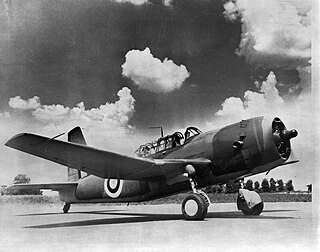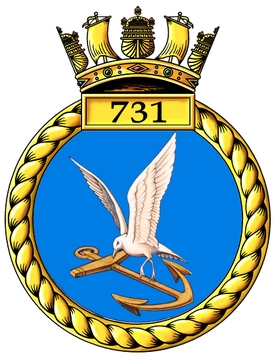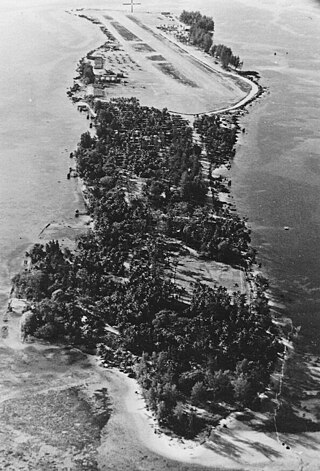
1790 Naval Air Squadron was a Naval Air Squadron of the Royal Navy's Fleet Air Arm (FAA). It was formed on 1 January 1945 at RNAS Burscough as a night fighter squadron. It was initially equipped with the Fairey Firefly I, replaced in May 1945 by the Firefly INF, which was fitted with a US-derived ASV radar. The squadron joined HMS Vindex on 24 June, bound for Australia, with the ship arriving at HMS Nabthorpe 2 days before the war in the Far East ended. The squadron was disbanded on 3 June 1946 at Devonport.

Royal Air Force Kai Tak or more commonly RAF Kai Tak is a former Royal Air Force station situated in Hong Kong, at Kai Tak Airport, Kowloon. It was established by the Royal Air Force (RAF) in 1927 and used for seaplanes. The RAF flight operated a few land based aircraft as well as having spare aircraft for naval units.

The Sembawang Air Base is a military airbase of the Republic of Singapore Air Force (RSAF) located at Sembawang, in the northern part of Singapore. The base motto is Swift and Resolute.
HMS Nabbington, was a Royal Navy (RN), Mobile Operational Naval Air Base (MONAB), that was established at the Royal Australian Air Force (RAAF) base RAAF Nowra at Nowra, New South Wales, in Australia during the final stages of the Second World War. HMS Nabbington was also known as MONAB I and Royal Naval Air Station Nowra.
HMS Nabberley was a Royal Navy (RN), Mobile Operational Naval Air Base (MONAB) at the Royal Australian Air Force (RAAF) base RAAF Bankstown in Sydney, Australia. HMS Nabberley was also known as MONAB II and Royal Naval Air Station Bankstown.

778 Naval Air Squadron was a Naval Air Squadron of the Royal Navy's Fleet Air Arm. During the Second World War the squadron was a Service Trials Unit (STU) initially based at HMS Daedalus, RNAS Lee-on-Solent, Hampshire, England before moving to HMS Condor, RNAS Arbroath, Angus, Scotland on 6 July 1940. The squadron tested all types of aircraft that could be used by the Royal Navy. Key to this was testing new types for deck landing on aircraft carriers. Such aircraft included various types of Supermarine Seafires, Grumman Hellcats, Grumman Martlets, Grumman Avengers, and Vought Corsairs. The squadron was reformed on 5 November 1951 with Douglas Skyraider AEW.1 but was disbanded on 7 July 1952 to form the basis of 849 Naval Air Squadron.

706 Naval Air Squadron was a Naval Air Squadron of the Royal Navy's Fleet Air Arm. Established as a fighter and torpedo-bomber training unit in Australia at the end of World War Two, it was briefly reformed as a helicopter squadron in the early 1950s, before becoming a helicopter training unit in 1962, and operating until 1998.

885 Naval Air Squadron was a Naval Air Squadron of the Royal Navy's Fleet Air Arm. First formed on 1 March 1941, the squadron served as a fighter squadron during the Second World War. It operated in the Mediterranean in 1942–43, where it took part in Operation Torch, the Anglo-American invasion of French North Africa, the Allied invasion of Sicily and the Allied invasion of Italy. In 1944 it took part in the Allied invasion of Normandy, spotting for Allied artillery bombardments and in 1945, was deployed as part of the British Pacific Fleet. It was abolished for the last time on 27 September 1945.

887 Naval Air Squadron was a Naval Air Squadron of the Royal Navy's Fleet Air Arm, which last disbanded during March 1946. It was formed as a Fleet Fighter squadron in May 1942 at HMS Daedalus, RNAS, Lee-on-Solent. The squadron embarked in HMS Unicorn during 1943 for convoy escort duties and later in the year to cover the allied landings at Salerno, Italy. At the end of 1943 it formed part of the 24th Naval Fighter Wing. 1944 saw it embark in HMS Indefatigable and the squadron saw action in operations against the german battleship Tirpitz during early 1944 and then joined the British Pacific Fleet at the end of the year. It was part of the attacks on the oil refineries at Palembang at the start of 1945 and later in the year it was involved in sorties around Tokyo, as part of the 7th Carrier Air Group, before V-J Day.

721 Naval Air Squadron was a Naval Air Squadron of the Royal Navy's Fleet Air Arm (FAA). 721 Naval Air Squadron formed at HMS Gadwall, RNAS Belfast, Northern Ireland, at the beginning of March 1945, as a Fleet Requirements Unit for the British Pacific Fleet. Initially equipped with Vultee Vengeance target tugs, it arrived at HMS Nabaron, RNAS Ponam, Admiralty Islands in May 1945, and commenced operations towing targets. The squadron moved to HMS Nabsford, RNAMY Archerfield, Brisbane, Australia, during October and then relocated to Hong Kong at the beginning of 1946, moving to HMS Nabcatcher, RNAS Kai Tak, where it eventually disbanded at the end of 1947.

731 Naval Air Squadron was a Naval Air Squadron of the Royal Navy's Fleet Air Arm (FAA). It was active between 1943 and 1945 and its sole role throughout its formation was a Deck Landing Control Officer training squadron. Through this role the squadron pilots were nicknamed 'Clockwork Mice'. It was based out of the purpose built airbase, commissioned as HMS Peewit, known as Royal Naval Air Station East Haven, in Scotland, as part of the Deck Landing Training School there.

748 Naval Air Squadron was a Naval Air Squadron of the Royal Navy's Fleet Air Arm. It was initially formed, at HMS Vulture, RNAS St Merryn, as a Fighter Pool Squadron, before becoming No. 10 Naval Operational Training Unit. The squadron moved to HMS Dipper, RNAS Henstridge, in February 1944 and then onto HMS Heron, RNAS Yeovilton in the March. In September 1944, 748 Naval Air Squadron moved to HMS Goldcrest, RNAS Dale, in Wales, remaining for just under twelve months, before moving back to HMS Vulture, RNAS St Merryn in August 1945, where it disbanded in February 1946. During its existence, the squadron was equipped with numerous aircraft and various marks, operated by the Fleet Air Arm.

757 Naval Air Squadron was a Naval Air Squadron of the Royal Navy's Fleet Air Arm. It was first formed as a Telegraphist Air Gunner Training Squadron in 1939, operating out of RNAS Worthy Down, but after three months it went into abeyance, only to reform again in the same role, at the same location, in 1941 and operating until 1942. It then reformed as a Fighter Pool Squadron & Operational Training Unit at RNAS Puttalam, in Sri Lanka, in 1943. After a brief spell at RNAMY Tambaram, in India, the squadron finally disbanded at RNAS Katukurunda, in Sri Lanka, at the beginning of 1946.

760 Naval Air Squadron is a Naval Air Squadron of the Royal Navy's Fleet Air Arm. The squadron first formed in April 1940 as No.1 Fleet Fighter Pool with a variety of aircraft types before standardising in 1941 on the Hawker Sea Hurricane. In this role it disbanded in December 1942. In May 1944 760 NAS briefly reformed as an Anti-Submarine Operational Training Squadron before disbanding into 766 Naval Air Squadron in November. Reformed again as part of No.1 Naval Air Fighter School in April 1945 it converted fighter pilots to the Vought Corsair and then the Supermarine Seafire until 23 January 1946 when it disbanded.

768 Naval Air Squadron was a Naval Air Squadron of the Royal Navy's Fleet Air Arm (FAA). It last disbanded at HMS Gannet, RNAS Eglinton, Northern Ireland, in March 1949, having been formed as a Deck Landing Control Officer Training Squadron, in December 1948, to ensure one American-style signal trained DLCO could be located at every FAA station. It first formed as part of the Deck Landing Training School at HMS Condor, RNAS Arbroath, in January 1941, as a Deck Landing Training Squadron. Advanced training was in HMS Argus, for which a detachment was maintained at HMS Landrail, RNAS Machrihanish, where it wholly moved to in March 1943. September saw a move to RAF Heathfield, Ayr, followed by a further move to HMS Sanderling, RNAS Abbotsinch in January 1944. Training used escort carriers on the Firth of Clyde and a detachment was maintained at (Heathfield)Ayr throughout this period, with the squadron returning there in July 1945, at this time HMS Wagtail, RNAS Ayr. In August the squadron moved to HMS Corncrake, RNAS Ballyhalbert in Northern Ireland but then in October it joined up with the Deck Landing School at HMS Peewit, RNAS East Haven, Scotland, where it disbanded in April 1946.

787 Naval Air Squadron was a Naval Air Squadron of the Royal Navy's Fleet Air Arm which disbanded in January 1956. It formed in March 1941, at HMS Heron, RNAS Yeovilton, out of 804 Naval Air Squadron as a Fleet Fighter Development Unit. Almost every type of fighter was received by the squadron for testing and evaluation for naval use. A move to RAF Duxford in June 1941 saw it become the Naval Air Fighting Development Unit, attached to the Royal Air Force's Air Fighting Development Unit. The squadron undertook rocket projectile test, continuous development of fighter tactics and even helping Torpedo Bomber Reconnaissance squadrons in evading fighter attack. Post Second World War it continued its trials task and also undertook Rebecca radar trials and ASH, US-built air-to-surface-vessel radar trials.

HMS Nabaron was a Royal Navy (RN) Mobile Operational Naval Air Base (MONAB) which was situated at the United States Navy (USN) airfield NAS Ponam Airfield on Ponam Island, Admiralty Islands in Papua New Guinea, which had been transferred to RN on loan. HMS Nabaron was also known as MONAB IV and Royal Naval Air Station Ponam.
HMS Nabsford was a Royal Navy (RN), Transportable Aircraft Maintenance Yard (TAMY), which was situated at the Royal Australian Air Force (RAAF) airfield RAAF Station Archerfield situated in Brisbane, Queensland. HMS Nabsford was also known as TAMY I and Royal Naval Aircraft Maintenance Yard Archerfield.
HMS Nabstock was a Royal Navy (RN), Mobile Operational Naval Air Base (MONAB) which was initially located at the Royal Australian Air Force (RAAF) airfield RAAF Maryborough situated in Maryborough, Queensland. HMS Nabstock was also known as MONAB VI and Royal Naval Air Station Maryborough, between June and November 1945. It decommissioned and moved to RAAF Station Schofields located at Schofields, New South Wales, where MONAB VI recommissioned as HMS Nabstock and known here as Royal Naval Air Station Schofields until June 1946.



















